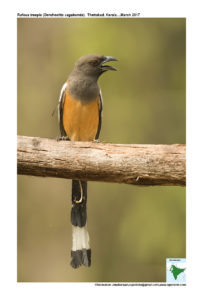Rufous Treepie

Rufous Treepie Dendrocitta vagabunda
Etymology:
- Dendrocitta : Greek word Dendron- tree; kitta – magpie.
- Vagabunda : Latin word for “ wandering” derived from vagareto wander
Vernacular Names:Baluchistan: Khata khan, Sind: Mahtab, Mata, Malang, Chand, Hindi: BhartiyaMahalat, Mootri, Mahtab, Sans: Krushakut, Pun: Lagoja, M.P: Chhotamahuka, Ben: Kotri, Taka chor, Handichacha, Ass: Kalokhoa, Chekcheki, Guj: Khakhedo, Kherkhatto, Mar: Takkachor, Ori: Harada phalia, Ta: Kanakkankuruvi, Val kakai, Te: Gokurayi, Kondakatigadu, Mal: Olen nali, Kanakkan,Kan: Mata pakshi
Distribution in India:Widespread resident in India.
Description: Size of 46–50 cm; wt. of 90–130 g. It is a large Treepie with long, strongly graduated tail, central feather pair is broadening towards tip, short bill with strongly curved culmen and cutting edges. The nominate race has entire head to breast and upper mantle sooty blackish, blackest on face and throat; upperparts are ginger-brown, paling to orange-buff on uppertail-coverts. The secondary upperwing-coverts and tertials are silvery grey, contrasting with black of rest of wing; central tail feathers are light silvery grey, shading paler towards tip, and ending in wide black terminal band, remainder of tail feathers are similar but progressively shorter, outermost is shortest with terminal half black. The lower underparts are buffy rufous, paling to orange-buff on undertail-coverts; iris is red or reddish-brown; bill and legs are blackish-grey. Both the sexes are similar. The juvenile has hood and mantle uniformly brown, rump, uppertail-coverts and underparts are creamy buff, and black areas of wings are browner than adult and wing panel is pale grey with rusty-cream tinges, tail feathers except central pair is with narrow rusty tips. The first-year aged has retained worn, brown primaries.
Habitat: It is found in open deciduous woodland of all kinds, from dry forest to moist broadleaf woodlands, agricultural country with scattered trees, town and city parks, large gardens and the like. It is found from lowland up to 2100 m.
Food habits:It is omnivorous, but primarily carnivorous. It eats large variety of insects and their larvae, such as crickets and grasshoppers, beetles, moths, wasps and ants, termites, spiders centipedes and snails, variety of small vertebrates, including contents of bird nests, small birds, small rodents, small bats, small snakes, frogs and lizards. It eats wild figs including Banyan and Peepul, and variety of other fruits including neem; raids orchards for cultivated fruits, especially figs, also mulberries and papaya. It visits flowering Bombax andErythrina trees for nectar at appropriate season. It is found usually in pairs or small family groups. It readily follows mixed-species groups of larger forest birds, especially Greater Racquet-tailed Drongos and various woodpeckers, nimbly catching moths or other insects disturbed from tree trunks or leaf litter by those species. It rides on backs of both domestic and wild large mammals, feeding on ectoparasites and anything that may be disturbed from underfoot. It forages on ground, with tail held raised, moving in short hops.
Breeding habits: They breed in May–Jun in North India and Mar–Apr in Kerala. They are solitary breeders. The nest is built by both sexes. The nest is rather small for size of bird, a flimsy cup of thin, usually thorny twigs, lined with rootlets and smaller twigs, above ground, often in quite exposed position in often isolated or prominent tree. Both the sexes build nest, feed young, and share incubation. They lay a clutch of 2–6 eggs.